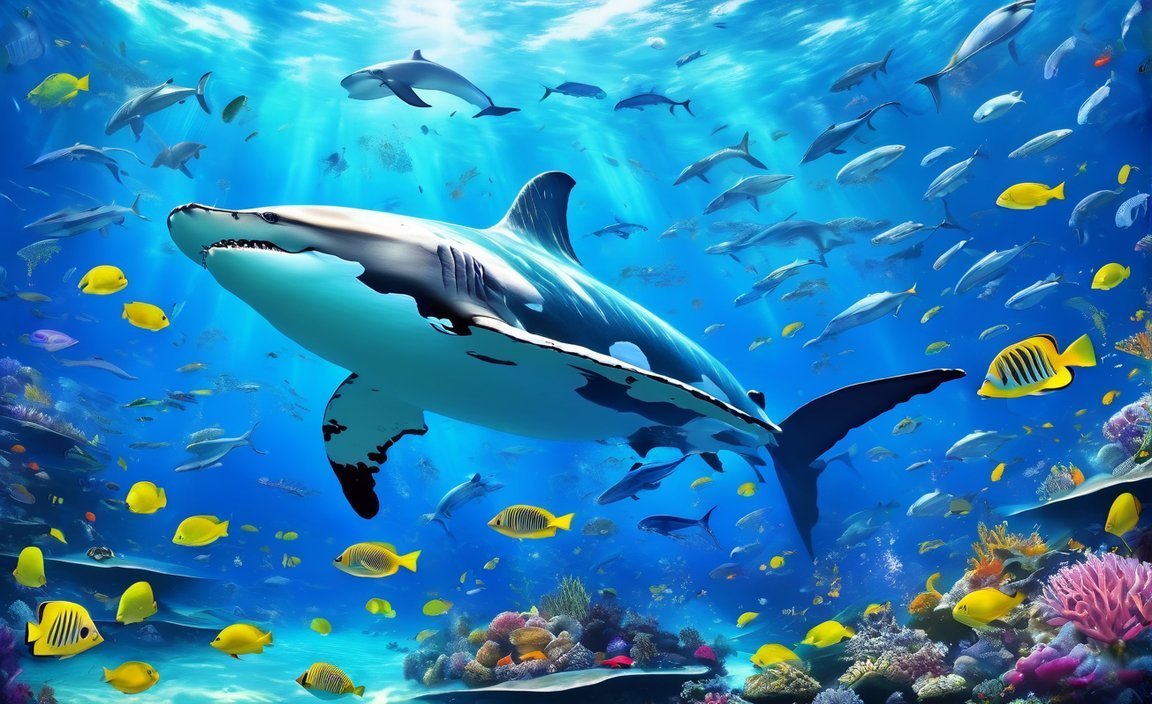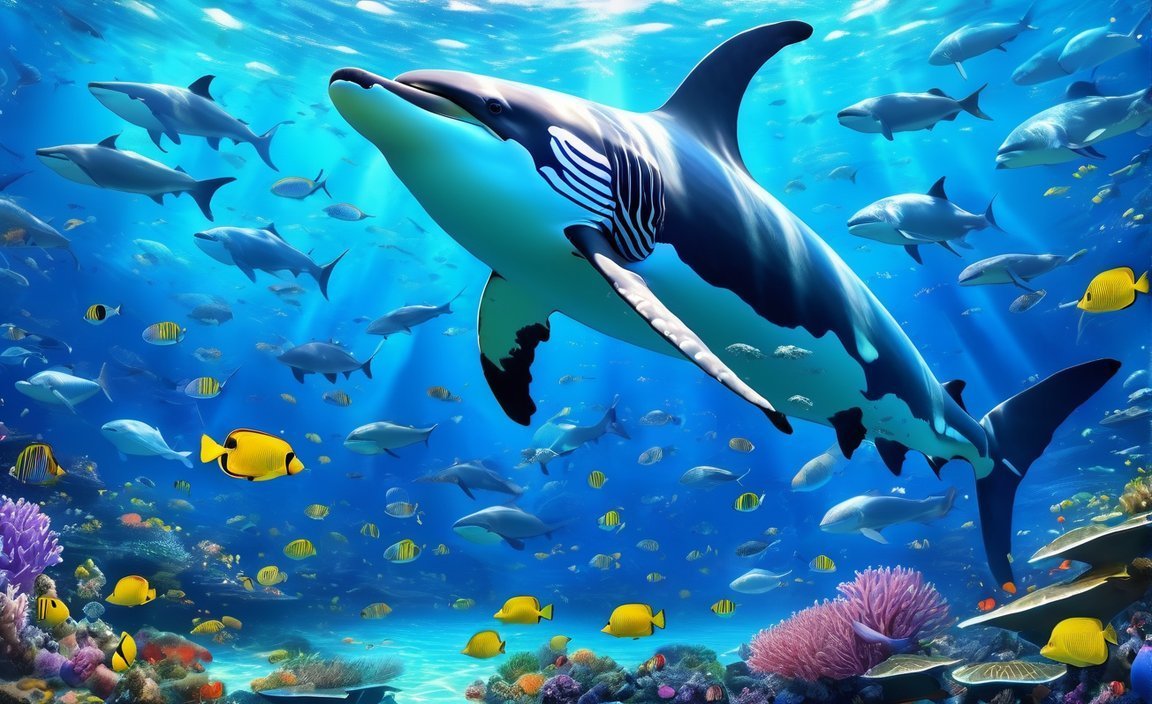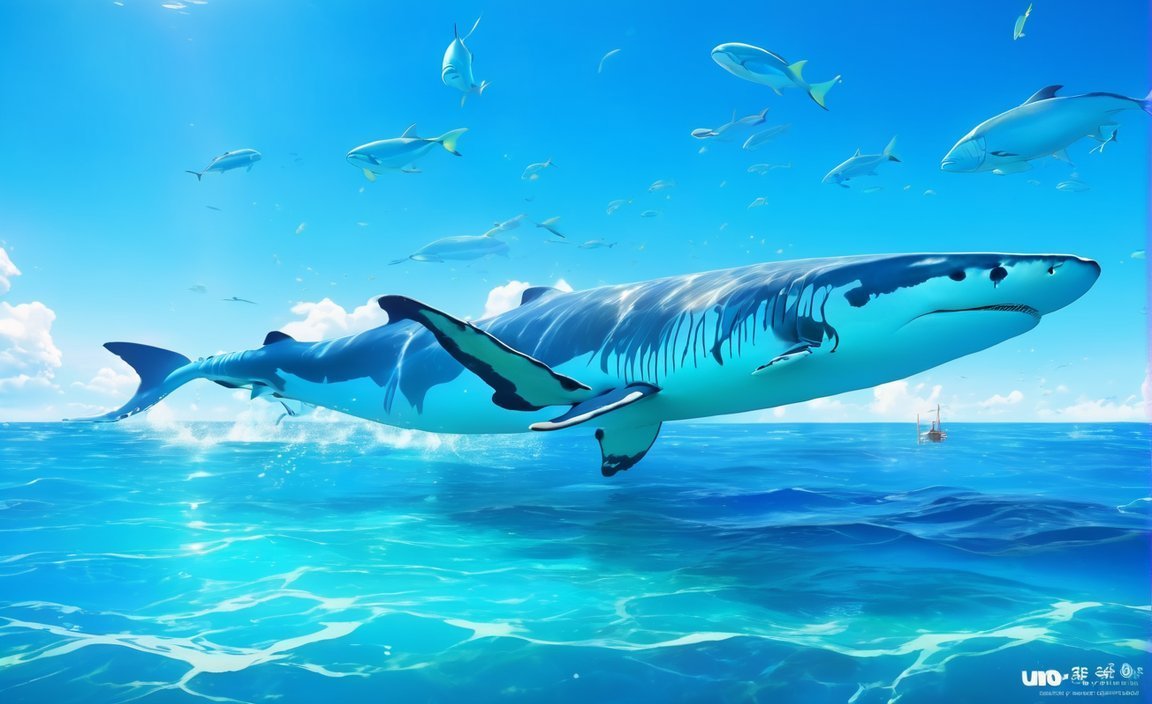Discover the enchanting realm of ocean animals and be captivated by ten fascinating facts that will leave you in awe. From the graceful dolphins to the enigmatic octopuses, these creatures of the deep hold intriguing mysteries waiting to be unraveled. As an experienced marine biologist with a passion for ocean conservation and a background in environmental research, I invite you to delve into the enthralling world of these mesmerizing animals and uncover their remarkable behavior, unique adaptations, and intriguing habitats. Get ready to embark on a journey of discovery as we explore the top ten lesser-known secrets of the ocean’s captivating inhabitants.

Key Takeaways:
- Seahorses are the only animals where the male gives birth and cares for their young.
- Shrimp have their heart located in their head.
- Sea sponges, despite their lack of organs, are alive.
- Turtles can be found on every continent, except Antarctica.
- Blue whales are the largest animals to have ever lived on Earth.
- Sea turtles have been around since the time of dinosaurs.
- Some sharks, like the great white shark, are warm-blooded.
- Sea lions, seals, and walruses with winged feet are called pinnipeds.
- Dolphins have excellent hearing and vision, while whales communicate by singing.
- Phytoplankton, tiny algae, are the primary producers of oxygen in the ocean.
10 Fascinating Facts About Ocean Animals
Have you ever wondered about the wondrous creatures that inhabit the vast depths of our oceans? Prepare to be amazed as we delve into the enigmatic world of ocean animals and uncover ten captivating facts that will leave you in awe.
1. Seahorses: The Unique Parents of the Sea
Did you know? Seahorses are the only animals in which the male, not the female, gives birth and cares for their young.
Step into the extraordinary life of seahorses, where gender roles are reversed. Unlike most animal species, it is the male seahorses who become pregnant, carrying hundreds of tiny seahorse babies in their pouches for several weeks until they are ready to be released into the world. This fascinating adaptation makes seahorses truly one-of-a-kind in the animal kingdom.
2. The Tiny Heart in a Shrimp’s Head
Did you know? A shrimp’s heart is located in their head.
Prepare to have your mind blown by the peculiar biology of shrimps. While you may think that a heart should be situated in the chest, shrimps challenge this notion. These remarkable ocean creatures house their hearts in their heads! This remarkable adaptation allows shrimps to efficiently circulate nutrients and oxygen throughout their bodies, sustaining their active lifestyles.
3. The Mystifying Wonder of Sea Sponges
Did you know? Sea sponges, despite having no head, mouth, eyes, feelers, bones, heart, lungs, or brain, are alive.
Enter the perplexing world of sea sponges, where the absence of typical organs doesn’t hinder their existence. These sedentary beings may lack complex body structures, but they are incredibly tenacious and resourceful. By drawing water in through their porous bodies, sea sponges filter out tiny particles, garnering sustenance from the ocean currents and turning adversity into an opportunity for survival.
4. Exploring the World of Turtles Across Continents
Did you know? Turtles can be found on every continent except Antarctica.
Embark on a journey that spans continents as we discover the widespread distribution of turtles. From the bustling shores of North America to the tranquil beaches of Australia, turtles have established their presence in diverse habitats worldwide. These resilient creatures have adapted to survive in various environments, serving as a testament to the adaptability and endurance of ocean animals.
5. The Magnificent Blue Whale
Did you know? The blue whale, which is as long as two school buses, is the largest animal to have ever lived on Earth.
Plunge into the depths of the ocean to encounter the colossal blue whale, a true behemoth of the seas. With a size that surpasses the length of two school buses, these gentle giants dominate the ocean realm. Witnessing the awe-inspiring presence of the blue whale is a humbling reminder of the grandeur that exists beneath the ocean’s surface.
6. The Resilience of Sea Turtles Throughout History
Did you know? Sea turtles have been around since the time of the dinosaurs.
Unearth the ancient origins of sea turtles, survivors from a time long past. These majestic creatures have inhabited our oceans for millions of years, persevering through changing environments and outlasting even the mighty dinosaurs. Today, they continue to captivate us with their grace and remind us of the resilience of ocean animals throughout Earth’s history.
7. The Remarkable Warm-Blooded Sharks
Did you know? Some sharks, like the great white shark, are warm-blooded.
Dive into the world of sharks and challenge conventional wisdom about their cold-blooded nature. While most sharks are known for their ability to regulate their body temperature based on the surrounding waters, some species, such as the great white shark, exhibit a rare characteristic – warm-bloodedness. This evolutionary adaptation allows them to pursue prey in colder waters, remaining agile and swift in their hunt.
8. The Whimsical World of Pinnipeds
Did you know? Sea lions, seals, and walruses, which have winged feet, are called pinnipeds.
Embark on a journey along the ocean’s coastline, where you’ll encounter the captivating pinnipeds. With their winged feet that streamline them through water and their exceptional adaptations for life both on land and at sea, sea lions, seals, and walruses embody the beauty and diversity of ocean animals. Witnessing their playful antics and graceful movements is sure to leave you spellbound.
9. The Extravaganza of Dolphin and Whale Communication
Did you know? Dolphins have excellent hearing and vision, while whales communicate by singing.
Plunge into the magical realm of communication among ocean animals. Dolphins, with their acute senses, deftly navigate through their underwater world, relying on both hearing and vision to interact with their surroundings. On the other hand, whales have perfected the art of melodic communication, serenading fellow whales with their mesmerizing songs that can travel for miles. These magnificent creatures demonstrate the diversity of communication methods within the oceanic realm.
10. The Unsung Heroes: Phytoplankton
Did you know? Most ocean plants are tiny algae called phytoplankton, which play a crucial role in producing oxygen.
Immerse yourself in the intricate web of life beneath the ocean’s surface, where tiny organisms hold immense power. Phytoplankton, the unsung heroes of ocean ecosystems, harness the sun’s energy and undergo photosynthesis, generating a significant portion of the Earth’s oxygen. These microscopic algae form the foundation of the marine food chain, sustaining countless other creatures and contributing to the delicate balance of the ocean.
In conclusion, the world of ocean animals is a captivating tapestry of wonders, teeming with unique adaptations, astonishing behaviors, and extraordinary beauty. Exploring the ten fascinating facts about these intriguing creatures only scratches the surface of the marvels that await in the depths of the ocean. So dive in and uncover the secrets of our awe-inspiring marine life!
Here are 10 fascinating facts about different biomes. Explore more about biomes by clicking here.
Discover interesting information about the process of condensation by clicking here.
Did you know that marine biology is a diverse field that studies life in the ocean? Learn more about it here.
Explore the wonders of marine life and discover interesting facts about it by clicking here.
Dive into the depths of the ocean and uncover intriguing facts about ocean life here.
Discover 10 interesting facts about temperate deciduous forests here.
Learn more about the unique characteristics of temperate forests by clicking here.
Explore the wonders of temperate rainforests with these 10 interesting facts here.
Uncover fascinating facts about the African savanna by clicking here.
Discover the incredible diversity of marine life here.
Learn more about the tropical savanna and its unique ecosystem here.
Strange and Fascinating Behaviors of Ocean Animals
The world beneath the ocean’s surface is teeming with life, and the behaviors of its inhabitants are nothing short of mesmerizing. From shape-shifting fish to decapitating sea slugs, here are 10 strange and fascinating facts about ocean animals that will leave you in awe of their incredible adaptations and behaviors.
1. Gender-Bending Fish
Some fish have the remarkable ability to change their gender. This behavior, called sequential hermaphroditism, allows certain species to switch between male and female reproductive roles. For example, some gobies and wrasses start their lives as one gender and transition to the other as they mature. It’s truly a puzzling and fascinating phenomenon!
2. Mighty Minnows
In the world of fish, size isn’t everything. The Paedocypris fish holds the title for being the smallest known fish, measuring just a few millimeters in length. Imagine encountering this minuscule marvel in the vast expanse of the ocean!
3. Giants of the Deep
While some fish may be tiny, others are truly colossal. The whale shark takes the crown as the largest fish in the ocean, growing up to a whopping 40 feet long. Its colossal size, distinctive markings, and gentle nature make encounters with these gentle giants truly unforgettable.
4. Enigmatic Deep Ocean
The deep ocean is often compared to deep space, mainly because studying it poses tremendous challenges. With its extreme depths, high pressures, and perpetual darkness, the deep ocean remains largely unexplored. Only approximately 20% of the world’s oceans have been studied, leaving a vast unknown waiting to be discovered.
5. Alien-Like Creatures
Venturing into the deep ocean reveals a world filled with peculiar and alien-like creatures. Many deep-sea dwellers possess unique adaptations that make them appear straight out of science fiction. Their otherworldly appearances and characteristics leave scientists astounded and continue to unravel the mysteries of adaptation and evolution.
6. Still Unseen
It’s mind-boggling to think that despite our best efforts, we have only scratched the surface when it comes to ocean exploration. Scientists estimate that a staggering 91% of marine animals are still unknown to us. The vast majority of ocean dwellers are yet to be identified, highlighting the incredible diversity that lies beneath the waves.
7. Weird and Wonderful
When it comes to weirdness, the ocean never disappoints. From the leafy sea dragon with its striking resemblance to a floating piece of seaweed to the anglerfish’s bizarre luminescent lure, and the red handfish’s unique hand-like fins, there is no shortage of oddities lurking in the depths. The ocean is indeed a treasure trove of nature’s quirkiest creations.
8. Deep Sea Survival Tactics
Surviving in the depths of the ocean requires some truly outlandish adaptations. Deep-sea creatures have evolved extraordinary strategies to thrive in their harsh environment. Some employ bioluminescent lures to attract prey, while others produce thick slime to deter predators. These astounding survival tactics demonstrate the remarkable resilience and resourcefulness of marine life.
9. A World of Shapes and Sizes
The ocean is home to creatures of all shapes and sizes, and many of them defy conventional expectations. From giant isopods, resembling oversized prehistoric insects, to the venomous and mesmerizing blue-ringed octopuses, the diversity of forms found in the ocean is truly astounding. Prepare to be amazed by the ocean’s endless parade of fascinating shapes and sizes.
10. Cool and Unusual Enigmas
Finally, our journey into the strange and fascinating behaviors of ocean animals leads us to the Irrawaddy dolphin and the armored snail. Found in different corners of the world, these creatures possess their fair share of oddities. The Irrawaddy dolphin’s distinctive appearance and playful nature have captivated many, while the armored snail’s unique shell serves as protection against the harsh environment it calls home.
Key Takeaways:
– The ocean harbors a wealth of strange and fascinating behaviors exhibited by its remarkable inhabitants.
– Sequential hermaphroditism allows certain fish species to change their gender during their lifetime.
– The Paedocypris fish holds the record for being the smallest fish, while the whale shark reigns as the largest.
– The deep ocean remains largely unexplored, with only 20% of the world’s oceans having been studied.
– Deep-sea creatures display peculiar and alien-like characteristics, captivating scientists with their adaptations.
– A vast majority of marine animals, estimated to be around 91%, are yet to be discovered and identified.
– The ocean is a haven for weird and wonderful creatures, each boasting unique characteristics and appearances.
– Deep-sea animals have evolved fascinating survival tactics, such as glowing lures and producing thick slime.
– Ocean animals come in a remarkable variety of shapes and sizes, from giant isopods to blue-ringed octopuses.
– The Irrawaddy dolphin and armored snail represent just a fraction of the cool and unusual enigmas found in the ocean.
Sources:
1. Nat Geo Kids
2. Facts on Tap
The Importance of Ocean Animals in the Ecosystem
The Earth’s oceans are a vast and captivating realm, home to an incredible variety of animal species. These ocean animals play a vital role in maintaining the health and balance of our planet’s ecosystems. Here are 10 fascinating facts that highlight the importance of ocean animals in the ecosystem.
Fact 1: Biodiversity Hotspots
The world’s oceans are teeming with life, making them biodiversity hotspots. They are home to an estimated 230,000 known species, with millions more waiting to be discovered. The diverse range of ocean animals contributes to the overall health and stability of marine ecosystems.
Fact 2: Oxygen Production
Ocean animals, particularly phytoplankton, play a crucial role in producing oxygen through photosynthesis. These tiny algae are responsible for about 50% of the oxygen generated on Earth. They form the foundation of the marine food chain and provide oxygen for countless organisms, including humans.
Fact 3: Nutrient Cycling
Ocean animals, such as fish and marine mammals, play a vital role in nutrient cycling within marine ecosystems. Through their feeding habits and waste production, they help distribute essential nutrients throughout the ocean, supporting the growth of other organisms.
Fact 4: Carbon Sequestration
Ocean animals, including marine plants and algae, play a significant role in carbon sequestration. They absorb carbon dioxide from the atmosphere through photosynthesis and store it in their tissues. This helps mitigate the impacts of climate change by reducing the amount of greenhouse gases in the atmosphere.
Fact 5: Food Web Balance
Ocean animals are integral to maintaining a balanced and healthy food web in marine ecosystems. Each species occupies a specific niche, regulating populations of other organisms and preventing the dominance of any single species. This balance is crucial for the overall stability and resilience of the ecosystem.
Fact 6: Seafood and Global Economy
Ocean animals provide a vital source of food and income for millions of people around the world. The fishing industry sustains economies and livelihoods, particularly in coastal communities. However, sustainable fishing practices are crucial to ensure the long-term health and abundance of ocean animal populations.
Fact 7: Medicinal Discoveries
Many ocean animals have unique bioactive compounds and chemical properties that hold potential for medical advancements. From coral reef organisms to deep-sea creatures, the study of ocean animals has led to the discovery of new drugs and treatments for various diseases and conditions.
Fact 8: Habitat Creation and Protection
Ocean animals, such as coral reefs and kelp forests, create intricate habitats that support a wide range of other species. These habitats provide shelter, breeding grounds, and nurseries for countless marine organisms. Protecting and restoring these habitats is essential for maintaining biodiversity and the overall health of marine ecosystems.
Fact 9: Climate Regulation
Ocean animals, particularly marine mammals, play a role in climate regulation through their movement and behavior. For example, whales transport nutrients from deep waters to the surface through their feeding habits, which supports the growth of phytoplankton and contributes to carbon sequestration.
Fact 10: Economic and Ecological Value
Ocean animals hold economic and ecological value beyond their intrinsic beauty and importance. They contribute to tourism, recreational activities, and scientific research, driving economies and providing inspiration for innovation and conservation efforts.
Key Takeaways:
- Ocean animals are essential for maintaining biodiversity and the health of marine ecosystems.
- Phytoplankton, ocean plants, and algae produce a significant amount of the Earth’s oxygen through photosynthesis.
- Ocean animals play a vital role in nutrient cycling and carbon sequestration, helping regulate global climate patterns.
- The balance of marine food webs depends on the interactions between different ocean animal species.
- Sustainable fishing practices are necessary to ensure the long-term abundance of ocean animal populations.
- Ocean animals have the potential to unlock medical discoveries and provide solutions for various diseases and conditions.
- Protecting and restoring ocean habitats, such as coral reefs and kelp forests, is critical for maintaining biodiversity.
- Certain ocean animals, like whales, contribute to climate regulation through their movement and feeding habits.
- Ocean animals have economic and ecological value, supporting tourism, recreational activities, and scientific research.
Sources:
– All That’s Interesting: link
– Science ABC: link
The Endangered Status of Certain Ocean Animal Species
The ocean is home to a diverse array of magnificent creatures, but sadly, some of these species are on the brink of extinction. The endangered status of certain ocean animal species is a pressing issue that calls for urgent attention and action. In this article, we will explore the plight of these remarkable animals and shed light on their predicament.
Hawaiian Monk Seal
One of the most endangered marine mammals, the Hawaiian Monk Seal faces numerous threats to its survival. Historically, it has been relentlessly hunted and poached for its meat, oil, and skin. With only two remaining species in the monk seal family, the Hawaiian Monk Seal holds a critical place in our oceans.
Vaquita
Living exclusively in Mexico’s Gulf of California, the Vaquita is the smallest cetacean species, measuring a mere 1.5 meters. Sadly, its population has drastically declined due to bycatch in fishing nets. As one of the most elusive dolphins, the Vaquita desperately needs protection to prevent its extinction.
North Atlantic Right Whale
Once boasting a population of 480 individuals in 2011, the North Atlantic Right Whale has seen a significant decline to fewer than 340 individuals by 2021. Entanglement in fishing gear and vessel strikes are the primary reasons behind this decline. Urgent conservation efforts are necessary to safeguard these majestic creatures.
Hawksbill Turtles and Kemp’s Ridley Turtles
Both Hawksbill Turtles and Kemp’s Ridley Turtles are critically endangered species falling under the category of threatened or endangered sea turtles. The valuable shell of Hawksbill Turtles has made them vulnerable to exploitation, while Kemp’s Ridley Turtles face threats from habitat loss and incidental capture. Protecting their habitats and establishing conservation programs are crucial for their survival.
Yangtze Finless Porpoise
Endemic to China’s Yangtze River, the Yangtze Finless Porpoise is one of the few remaining species in the area. However, the river’s pollution and human activities pose serious threats to its survival. Ensuring the restoration and protection of the Yangtze River is vital for the future of these remarkable porpoises.
These are just a few examples of the endangered ocean animal species that urgently need our attention and action. By understanding their unique challenges and advocating for conservation efforts, we can make a difference in preserving their future.
Key Takeaways:
- The Hawaiian Monk Seal faces heavy poaching and hunting, making it one of the most endangered marine mammals.
- The Vaquita, a small and elusive dolphin, is at the brink of extinction due to bycatch in fishing nets.
- The North Atlantic Right Whale’s population has declined significantly, primarily due to entanglement in fishing gear and vessel strikes.
- Hawksbill Turtles and Kemp’s Ridley Turtles are critically endangered species, facing threats such as exploitation and habitat loss.
- The Yangtze Finless Porpoise is endemic to China’s polluted Yangtze River, putting its survival at risk.
Sources:
– Marine Insight – 10 Endangered Ocean Species and Marine Animals
– Smithsonian Ocean – Endangered Ocean Animals

FAQ
Q1: Are seahorses the only animals in which the male gives birth and cares for their young?
A1: Yes, seahorses are unique in that the male carries the eggs and gives birth to the young, as well as providing parental care.
Q2: Where is a shrimp’s heart located?
A2: A shrimp’s heart is located in its head, rather than in its chest like in most animals.
Q3: Are sea sponges considered living organisms?
A3: Yes, despite lacking organs and a centralized nervous system, sea sponges are alive and form an essential part of marine ecosystems.
Q4: Can turtles be found on every continent?
A4: Turtles can be found on every continent except Antarctica, showcasing their wide distribution across the globe.
Q5: Which animal is the largest to have ever lived on Earth?
A5: The blue whale holds the title for being the largest animal to have ever lived on Earth, reaching lengths comparable to two school buses.
- Champy, Lake Champlain’s Monster: Exploring the Evidence and the Enigma - November 25, 2024
- Do Police Ticket Quotas Really Exist? A State-by-State Investigation - November 25, 2024
- Champy: Unveiling the Mysteries of Lake Champlain’s Legendary Monster - November 25, 2024
















